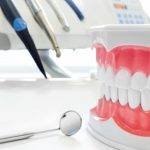The orthodontic industry excels in precision and innovation, utilizing advanced tools and devices for diagnosing and treating dental issues. Each step, from the initial exam to the final adjustment of braces, relies on specialized instruments for accuracy and effectiveness. This innovation enhances care quality and broadens the possibilities in dental correction, leading to improved patient outcomes.
TYPES OF ORTHODONTIC INSTRUMENTS
The orthodontic toolkit is as diverse as it is precise. Here, we break down the essential categories and instruments within each domain.
Diagnostic Instruments
Before any treatment can begin, diagnostics pave the way for a well-informed approach.
- Intraoral Examination Mirrors: These reflective surfaces allow dental professionals to see a magnified and inverted image inside a patient’s mouth, aiding in the detection of hard-to-see issues.
- Radiographs and Scans: From periapical and panoramic radiographs to cone-beam CT scans, these imaging techniques provide a detailed look at the craniofacial structure, critical for treatment planning.
Bonding Instruments
The process of bonding brackets to teeth is both intricate and crucial for the efficacy of the treatment. It involves the use of chemical aids such as etchants, primers, and bonding adhesives, which ensure that the fixtures stay in place, optimizing both patient comfort and dental health. A key step in this process is the use of a curing light for adhesives. This light cure unit polymerizes the bonding materials, transforming them into a hardened structure that is suitable for prolonged use.
Brackets
The anchor of the orthodontic system, brackets, are available in various materials and types. These range from traditional stainless steel to modern ceramics, with each material offering its advantages and considerations. Precision in the placement of these brackets is vital, employing techniques such as direct and indirect bonding to optimize their placement for an effective treatment.
Archwires
These metal brackets are essential in guiding the movement of teeth throughout the orthodontic process. There are various wire types involved; different stages and strategies of treatment necessitate different archwire types, which vary in shape and material. Additionally, the use of bending and soldering tools, such as orthodontic pliers and soldering instruments, allows for the customization of archwires to adapt to the changing needs of the treatment process.
Elastics And Ligatures
Elastics and ligatures are key in fine-tuning orthodontic force distribution. Elastic bands, ranging from power chains to interarch and intraarch elastics, may seem small but have a significant impact on treatment outcomes. When it comes to securing an archwire to the brackets, there are several ligature options available, including elastomeric and steel, catering to various needs and preferences.
Forceps And Pliers
These tools, commonly used for bracket placement and removal, must be handled with expertise. They feature purpose-specific designs, from Tweed pliers for bracket removal to utility pliers for various adjustments, with each tool serving a unique role in the treatment process. Furthermore, specialized pliers, such as Weingart pliers and those designed for distraction osteogenesis, require a surgeon’s precision for their safe and effective use.
Auxiliary Wires And Springs
For more complex cases, these instruments are essential in creating space or controlling individual tooth movement. Spring Devices, such as expansion springs and retraction springs, deliver the necessary force for specific treatment goals. Meanwhile, Fixed Devices like transpalatal arches and quad-helix appliances are cemented in place within the mouth, playing a vital role in the orthodontic force system.
Headgear
Sometimes necessary, headgear is used to apply external forces to guide or restrict facial growth and tooth movement. There are various types and uses for headgear, ranging from high-pull to reverse-pull configurations. Each type targets different problem areas and facial structures, making them a versatile tool in orthodontic treatment.
Retention Appliances
Once the active phase of treatment is complete, retention is maintained by custom devices such as Hawley retainers and Essix retainers. These retention appliances are essential for ensuring smile retention and proper dental alignment, necessitating a long-term commitment from both the patient and orthodontic professionals.
CHOOSING THE RIGHT INSTRUMENTS FOR DIFFERENT PROCEDURES
Selecting the right instrument is as much an art as using it. To match tools with treatment strategies, consider several factors such as understanding the malocclusion, the stage of treatment, patient needs, and clinician preference, all of which are key to choosing the optimal orthodontic instruments. Each instrument selection must be tailored to the specifics of the case at hand to ensure efficient and effective treatment.
PROPER CARE AND MAINTENANCE OF ORTHODONTIC INSTRUMENTS
The longevity and efficacy of Orthodontic Instruments – Wholedent significantly depend on their maintenance and care. Strict sterilization and disinfection protocols are indispensable in the orthodontic field to prevent cross-contamination, highlighting the importance of professional handling. Additionally, with careful use and professional maintenance, the lifespan of these orthodontic instruments can be extended, ensuring your investment is protected for years to come.
NEW AND EMERGING TECHNOLOGIES IN ORTHODONTIC INSTRUMENTATION
The orthodontic field continues to innovate with new and advanced tools.
- Self-Adjusting Braces: Orthodontic brackets that can self-adjust, reducing the need for frequent in-office adjustments, and potentially the duration of treatment.
- Clear Aligner Systems: A growing trend, clear aligner systems offer an alternative to traditional wire braces, preferred for their aesthetics and convenience.
- Digital Scanning and 3D Printing: Cutting-edge technology that allows for the creation of customized appliances with unparalleled accuracy and speed.
IN CONCLUSION
Orthodontic instruments are crucial for successful treatment. Understanding their role, use, and maintenance helps dental professionals provide efficient care and top-quality treatment. It’s vital to invest in ongoing education and stay updated with technological advancements in orthodontics.
For both experienced orthodontists and dental students, mastering orthodontic instruments can elevate your practice and help patients achieve their best smiles. Patient outcomes depend significantly on the tools and techniques used, making this guide a must-read for anyone in dentistry.



